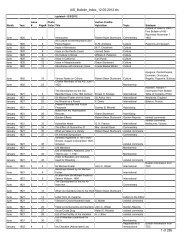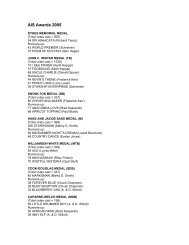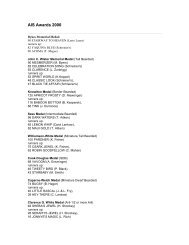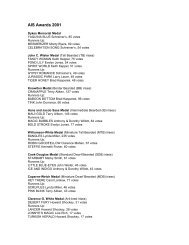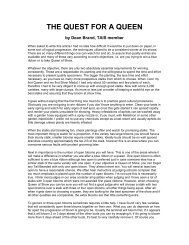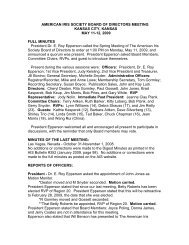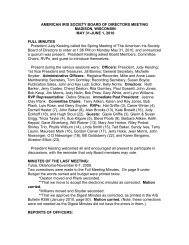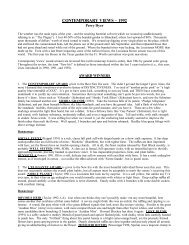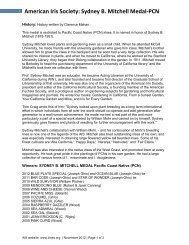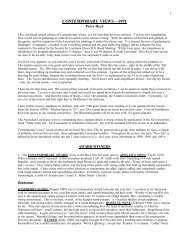contemporary views – 1988 award winners - American Iris Society
contemporary views – 1988 award winners - American Iris Society
contemporary views – 1988 award winners - American Iris Society
Create successful ePaper yourself
Turn your PDF publications into a flip-book with our unique Google optimized e-Paper software.
amazing increase. The flowers are large and well structured, holding together even in the most adverse weather conditions<br />
Oklahoma can throw at it. The backup buds expand to the same size as the principal blooms, and the branching is<br />
beautifully spaced in a modified candelabra. The rich glossy flowers of black satin have just enough ruffling to complete<br />
the form. And, incredibly, ‘Holy Night’ is a proven rebloomer. Here last year, it began its second season of bloom in<br />
October and continued until the first hard freeze the last week of November. All this, and our Awards Chairman can’t even<br />
get the name spelled right on the <strong>award</strong>s list <strong>–</strong> oh well!!!<br />
Runnersup:<br />
NEUTRON DANCE (Blyth 1987) is a “sin-sational” yellow amoena, the brightest and best on the market. Completely<br />
sunfast, a beacon shining across the garden. Vigorous, strong plants produce stalks of moderate height with 3 well-placed<br />
branches and plenty of backup buds. Miss Kitty will be pleased to see this one listed, for it was her favorite in the garden<br />
this year. CHAMPAGNE ELEGANCE (Niswonger 1987) is one I originally overlooked (or ignored). The color scheme<br />
is a sophisticated bitoning and blending of champagne and pink tones, finished with an elegant diamond-dusting over the<br />
entire flower. A good companion for ‘Holy Night’, having all the same qualities but on shorter stalks. The coloration<br />
will vary with the season, moisture, and mineral content of the soil, but rather than a defect, it adds to the enchantment.<br />
(Judges, be careful with this one on the bench. Those artificial lights can be especially tricky with this one!). Also a<br />
dependable rebloomer, reported to be a near ever-bloomer in the temperate, Mediterranean climates. Another Barry Blyth<br />
original completes this group: TOUCH OF BRONZE (1983) is a superb garden variety that consistently produces great<br />
show stalks also, although shorter and more delicate than some. An unusual shade of powder blue (with some slate<br />
undertones, but not drab), capped with shocking deep blue beards that are heavily tipped deep brown. The visual<br />
impression is a black beard, and against the light blue flowers, gives a dramatic effect. Smaller, compact flowers are in<br />
compliance with the shorter, leaner stalks. But the flowers are fat and wide and nearly tailored (just some light waving).<br />
Buds galore, and I hybridized nearly every one this year <strong>–</strong> in between showers. Barry is already getting a wide array of<br />
unbelievable offspring from this one, including the wonderful blue on white “barely-plic” with red beards, ‘Lipstick Lies’.<br />
I predict this one will be a Progenitor in TB and BB breeding.<br />
5. The DARK HORSE AWARD is given to the variety introduced within the past 10 years that I feel has been<br />
overlooked by AIS judges, and deserves/deserved higher <strong>award</strong>s. I’m pleased to see that last year’s winner, ‘Bay Ruffles’<br />
(Warburton 1985) has gone on to win the second most number of HM votes in the SDB class this year. The Dark Horse<br />
winner for this year is: AZTEC SUN (Dyer 1982). Surprise! Those of you that know me personally know that I’m not<br />
the type of hybridizer that goes around the country bragging and politicking my own things. If anything, I tend to be<br />
overly-critical and harsh with my work. My philosophy is to choose the right thing to release, put its best foot forward<br />
and try to get good distribution, then sit back and see what the public and the AIS judges think. I will take exception this<br />
time and just say that I think ‘Aztec Sun’ deserved more than it was <strong>award</strong>ed, although it did win a decent HM. Over the<br />
years, I have come to respect this brilliant yellow with deeper beards more and more. The richest, totally sunfast full<br />
yellow (not golden yellow) I’ve seen. Leathery, smooth substance. Branching and bud count can be excellent, and I’ve<br />
gotten to get to see it win Best of Show honors more than once. A vision of health and vigor, with husky blue-green<br />
foliage. My finest TB introduction (so far).<br />
Runnersup:<br />
RUFFLED SURPRISE (Rudolph 1981) is a hauntingly beautiful jungle blend of smoked-violet standards atop ecru-ivory<br />
falls that are distinctively banded with a chartreuse-gold band, and then smoked. Form is perfection par excellence,<br />
finished with heavy ruffling. Totally different from the type of work you would anticipate from the late great Nate<br />
Rudolph’s program, yet one of his finest achievements. And it is proving to be a sensational parent whose possibilities<br />
haven’t been fully tapped. I am still using it heavily. Had GENIALITY (O. Brown 1981) been a midseason bloomer<br />
rather than one of the last to open (after all the judges are pooped and “traveled out”), it would have easily won an AM.<br />
An elegant, melodious bicolor, with standards of medium rosy-pink and the falls in mauve-pink, tapped with deep shrimp<br />
beards. Deep pink style arms pull the two colors together, and the whole flower is finished with heavy lace. Ironically,<br />
one of its parents came from Nate Rudolph: The classic ‘Pink Sleigh’. In a world full of all kinds of crazy, zany plic<br />
patterns, PURPLE PEPPER (Nearpass 1986) is unique. Well named, it has pansy purple standards and white ground<br />
falls that are almost completely bombasted with a heavy peppering of purple even deeper than the standards’ color.<br />
Smoothly tailored, with none of that silly lace that would ruin a color pattern such as this. Mixing this with the more<br />
popular plic lines today should be quite a combination!<br />
6. The CREAM OF THE CROP AWARDS go to the 5 varieties on the Dykes Medal eligibility list that I consider the<br />
most worthy, in order of preference: EXTRAVAGANT (Hamblen 1983), last year’s Sun Belt Award winner, deserved a<br />
second chance, so to speak. And had the AIS Board of Directors responded properly to the petition presented them last<br />
fall, there would have been a runoff for the Dykes this year, and ‘Extravagant’ would have been one of the players…..<br />
42



